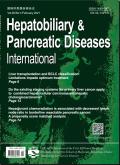Safety and efficacy of hypofractionated radiotherapy combined with tyrosine kinase inhibitors in patients with lung metastases after liver transplantation for hepatocellular carcinoma
IF 4.4
3区 医学
Q2 GASTROENTEROLOGY & HEPATOLOGY
Hepatobiliary & Pancreatic Diseases International
Pub Date : 2025-08-10
DOI:10.1016/j.hbpd.2025.07.003
引用次数: 0
Abstract
Background
Lung metastases often occur after orthotopic liver transplantation (OLT) for hepatocellular carcinoma (HCC). This study aimed to evaluate the safety and efficacy of combining hypofractionated radiotherapy (HFRT) with tyrosine kinase inhibitors (TKIs) in patients with lung metastases from HCC following OLT.
Methods
We retrospectively analyzed forty-eight patients with lung metastases post-OLT for HCC, who underwent concurrent HFRT and TKIs between July 2011 and August 2022. The primary endpoint was progression-free survival (PFS), and secondary endpoints included overall survival (OS), local control rate (LCR), in-field objective response rate (ORR), and treatment-related side effects.
Results
The median follow-up duration was 42.3 months, with median PFS and OS of 9.9 and 32.7 months, respectively. PFS rates at 1, 2, and 3 years were 33.3%, 20.8%, and 12.5%, respectively, whereas corresponding OS rates were 91.7%, 70.8%, and 33.3%, respectively. Independent adverse factors for PFS included the presence of > 3 lung metastases, interval time from OLT to lung metastasis < 1 year, and post-HFRT lymphocyte nadir < 0.8 × 109/L. For OS, independent adverse factors included shorter PFS time, shorter intervals from OLT to lung metastasis, and post-HFRT lymphocyte nadirs < 0.8 × 109/L. The 1- and 2-year LCRs for lung metastases were 100% and 85.3%, respectively. The best in-field ORR was 95.5%, with no adverse events exceeding grade 2. Radiation pneumonitis occurred in 32 patients (66.7%), with grade 1 in 28 patients (58.3%) and grade 2 in 4 patients (8.3%).
Conclusions
The combination of HFRT with TKIs is a feasible, safe, and promising approach for treating lung metastases from HCC post-OLT.
低分割放疗联合酪氨酸激酶抑制剂治疗肝癌肝移植后肺转移患者的安全性和有效性
背景:肝细胞癌(HCC)原位肝移植(OLT)后经常发生肺转移。本研究旨在评估低分割放疗(HFRT)联合酪氨酸激酶抑制剂(TKIs)治疗肝细胞癌肺转移患者OLT后的安全性和有效性。方法:我们回顾性分析了48例肝细胞癌olt后肺转移患者,这些患者在2011年7月至2022年8月期间同时接受了HFRT和TKIs。主要终点是无进展生存期(PFS),次要终点包括总生存期(OS)、局部控制率(LCR)、现场客观缓解率(ORR)和治疗相关副作用。结果:中位随访时间为42.3个月,中位PFS和OS分别为9.9和32.7个月。1年、2年和3年的PFS分别为33.3%、20.8%和12.5%,而相应的OS分别为91.7%、70.8%和33.3%。PFS的独立不良因素包括存在bbb3肺转移,OLT到肺转移的间隔时间< 1年,hfrt后淋巴细胞最低点< 0.8 × 109/L。对于OS,独立的不利因素包括PFS时间较短,OLT到肺转移间隔较短,hfrt后淋巴细胞最低点< 0.8 × 109/L。肺转移的1年和2年lcr分别为100%和85.3%。现场最佳ORR为95.5%,无不良事件超过2级。放射性肺炎32例(66.7%),其中1级28例(58.3%),2级4例(8.3%)。结论:HFRT联合TKIs治疗肝细胞癌olt后肺转移是一种可行、安全、有前景的治疗方法。
本文章由计算机程序翻译,如有差异,请以英文原文为准。
求助全文
约1分钟内获得全文
求助全文
来源期刊
CiteScore
5.40
自引率
6.10%
发文量
152
审稿时长
3.0 months
期刊介绍:
Hepatobiliary & Pancreatic Diseases International (HBPD INT) (ISSN 1499-3872 / CN 33-1391/R) a bimonthly journal published by First Affiliated Hospital, Zhejiang University School of Medicine, China. It publishes peer-reviewed original papers, reviews and editorials concerned with clinical practice and research in the fields of hepatobiliary and pancreatic diseases. Papers cover the medical, surgical, radiological, pathological, biochemical, physiological and historical aspects of the subject areas under the headings Liver, Biliary, Pancreas, Transplantation, Research, Special Reports, Editorials, Review Articles, Brief Communications, Clinical Summary, Clinical Images and Case Reports. It also deals with the basic sciences and experimental work. The journal is abstracted and indexed in SCI-E, IM/MEDLINE, EMBASE/EM, CA, Scopus, ScienceDirect, etc.

 求助内容:
求助内容: 应助结果提醒方式:
应助结果提醒方式:


